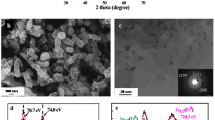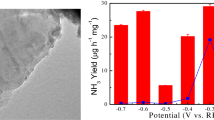Abstract
The development of new energy storage and conversion pathways has gradually freed people from dependence on oil, and improving conversion efficiency and safety is still the mainstream trend in the development of new energy sources, and electrode catalysts have become crucial in solving these problems. At present, precious metal catalysts have good performance, but the scarcity of resources and the high price limit commercialization. Therefore, it is very important to develop a catalyst for commercialization. In this paper, the Pt nanoparticles were successfully loaded on the mesoporous FeCo2O4 nanosheet catalyst by the sodium borohydride (NaBH4) reduction method. The formation of the Pt-O bond results in covalent coupling between Pt and FeCo2O4. The increase in defect sites also facilitates improved catalytic activity. According to the test results, the ORR process is mainly carried out through the "4-electron reaction" pathway, and the main product is water, and the Tafel slope of Pt-FeCo2O4 (-73 mV dec−1) is smaller than that of Pt/C (-84 mV dec−1) and FeCo2O4 (-76 mV dec−1). The stability of Pt-FeCo2O4 to ORR (After 12 h, only 15.5% current density loss) is significantly higher than that of commercial Pt/C. Meanwhile, in the OER process, Pt-FeCo2O4 (28.1 mA cm−2) has a higher current density than RuO2 (24.4 mA cm−2) and FeCo2O4 (15.1 mA cm−2). Therefore, Pt-FeCo2O4 can be used as a bifunctional catalyst to accelerate the ORR and OER processes, which has important theoretical research significance and commercial value.










Similar content being viewed by others
Data availability
Not applicable.
References
Hu C, Chen X, Dai Q, Wang M, Qu L, Dai L (2017) Earth-abundant carbon catalysts for renewable generation of clean energy from sunlight and water. Nano Energy 41:367–376
Xiong G, Chen Y, Zhou Z, Liu F, Liu X, Yang L, Liu Q, Sang Y, Liu H, Zhang X, Jia J, Zhou W (2021) Rapid synthesis of various electrocatalysts on Ni foam using a universal and facile induction heating method for efficient water splitting. Adv Funct Mater 31:2009580–2009590
Hu S, Wang S, Feng C, Wu H, Zhang J, Mei H (2020) Novel MOF-derived nickel nitride as high-performance bifunctional electrocatalysts for hydrogen evolution and urea oxidation. ACS Sustainable Chem Eng 8:7414–7422
Xu J, Li Q, Hansen M, Christensen E, Garcia A, Liu G, Wang X, Bjerrum NJ (2012) Antimony doped tin oxides and their composites with tin pyrophosphates as catalyst supports for oxygen evolution reaction in proton exchange membrane water electrolysis. Int J Hydrogen Energ 37:18629–18640
Hu Y, Guo M, Hu C, Dong J, Yan P, Isimjan T, Yang X (2022) Engineering cobalt nitride nanosheet arrays with rich nitrogen defects as a bifunctional robust oxygen electrocatalyst in rechargeable Zn-air batteries. J Colloid Interf Sci 608:2066–2074
Wang J, Fu Y, Xu Y, Wu J, Tian J, Yang R (2016) Hierarchical NiCo2O4 hollow nanospheres as high efficient bifunctional catalysts for oxygen reduction and evolution reactions. Int J Hydrogen Energ 41:8847–8854
Liu C, Sato K, Han X, Ye S (2019) Reaction mechanisms of the oxygen reduction and evolution reactions in aprotic solvents for Li-O2 batteries. Curr Opin Electroche 14:151–156
Wang T, Wu H, Feng C, Zhang L, Zhang J (2020) MoP@NiCo-LDH on nickel foam as bifunctional electrocatalyst for high efficiency water and urea–water electrolysis. J Mater Chem A 8:18106–18116
Wu H, Feng C, Zhang L, Zhang J, Wilkinson D (2021) Non-noble metal electrocatalysts for the hydrogen evolution reaction in water electrolysis. Electrochem Energy R 4:473–507
Conway B, Jerkiewicz G (2000) Relation of energies and coverages of under potential and over potential deposited H at Pt and other metals to the “volcano curve” for cathodic H2 evolution kinetics. Electrochim Acta 45:4075–4083
Fang X, Shang Q, Wang Y, Jiao L, Yao T, Li Y, Zhang Q, Luo Y, Jiang H (2018) Single Pt atoms confined into a metal-organic framework for efficient photocatalysis. Adv Mater 30:1705112
Xie Y, Cai J, Wu Y, Zang Y, Zheng X, Ye J, Cui P, Niu S, Liu Y, Zhu J, Liu X, Wang G, Qian Y (2019) Boosting water dissociation kinetics on Pt-Ni nanowires by N-induced orbital tuning. Adv Mater 31:1807780
Antolini E (2018) The oxygen reduction on Pt-Ni and Pt-Ni-M catalysts for low-temperature acidic fuel cells: a review. Int J Energ Res 42:3747
Li F, Liang J, Zhu W, Song H, Wang K, Li C (2018) In-situ liquid hydrogenation of m-chloronitrobenzene over Fe modified Pt/C nanotubes catalysts. Catalysts 8:62
Wu H, Gao P, Mu J, Miao Z, Zhou P, Zhou T, Zhou J (2022) Matryoshka-type carbon-stabilized hollow Si spheres as an advanced anode material for lithium-ion batteries. Chinese Chem Lett 33:3236–3240
Liu X, Hao S, Zheng G, Su Z, Wang Y, Wang Q, Lei L, He Y, Zhang X (2021) Ultrasmall Pt2Sr alloy nanoparticles as efficient bifunctional electrocatalysts for oxygen reduction and hydrogen evolution in acidic media. J Energy Chem 64:315–322
Deng Z, Pang W, Gong M, Jin Z, Wang X (2021) Revealing the role of mo doping in promoting oxygen reduction reaction performance of Pt3Co nanowires. J Energy Chem 66:16–23
Morozan A, Jousselme B, Palacin S (2011) Low-platinum and platinum-free catalysts for the oxygen reduction reaction at fuel cell cathodes. Energ Environ Sci 4:1238–1254
Sakai G, Arai T, Matsumoto T, Ogawa T, Yamada M, Sekizawa K, Taniguchi T (2014) Electrochemical and ESR Study on Pt-TiOx / C Electrocatalysts with Enhanced Activity for ORR. ChemElectroChem 1:366–370
Mohamed S, Tsai Y, Chen C, Tsai Y, Hung T, Chang W, Liu R (2015) Ternary spinel MCo2O4 (M = Mn, Fe, Ni, and Zn) porous nanorods as bifunctional cathode materials for lithium-O2 batteries. ACS Appl Mater Inter 7:12038–12046
Yan X, Jia Y, Zhang L, Yao X (2017) Platinum stabilized by defective activated carbon with excellent oxygen reduction performance in alkaline media. Chin J Catal 38:1011–1020
Wang C, Schechter A, Feng L (2023) Iridium-based catalysts for oxygen evolution reaction in acidic media: Mechanism, catalytic promotion effects and recent progress. Nano Research Energy 2:e9120056
da Silca G, Fernandes M, Ticianelli E (2018) Activity and stability of Pt/IrO2 bifunctional materials as catalysts for the oxygen evolution/reduction reactions. ACS Catal 8:2081–2092
Chen Z, Qing H, Zhou K, Sun D, Wu R (2019) Metal-organic framework-derived nanocomposites for electrocatalytic hydrogen evolution reaction. Prog Mater Sci 108:100618
Li G, Jang H, Liu S, Li Z, Kim M, Qin Q, Liu X, Cho J (2022) The synergistic effect of Hf-O-Ru bonds and oxygen vacancies in Ru/HfO2 for enhanced hydrogen evolution. Nat Commun 13:1270
Zhu K, Shi F, Zhu X, Yang W (2020) The roles of oxygen vacancies in electrocatalytic oxygen evolution reaction. Nano Energy 73:104761
Rashid B, Mala K, Ail M, Rafiq U, Quereshi M, Ahmad P, Dar M, Wahid M (2023) Temperature Ramp Strategy for Regulating Oxygen Vacancies in NiCo2O4 Nanoneedles Towards Enhanced Electrocatalytic Water Splitting. Chemphyschem e202300013. https://doi.org/10.1002/cphc.202300013
Kang S, Li S, Xiao X, Zhang Z, Shi Y, Zhao M, Wang Y (2022) Porous MCo2O4 (M = Zn, Cu, Fe, Mn) as high efficient bi-functional catalysts for oxygen reduction and oxygen evolution reaction. Nanotechnology 33:455705
Dong F, Liu X, Irfan M, Yang L, Li S, Ding J, Li Y, Khan IU, Zhang P (2019) Macaroon-like FeCo2O4 modified activated carbon anode for enhancing power generation in direct glucose fuel cell. Int J Hydrogen Energ 44:8178–8187
Liu L, Zhang H, Mu Y, Yang J, Wang Y (2016) Porous iron cobaltate nanoneedles array on nickel foam as anode materials for lithium-ion batteries with enhanced electrochemical performance. ACS Appl Mater Inter 8:1351–1359
Isarain-Chavez E, Baro M, Alcantara C, Pane S, Sort J, Pellicer E (2018) Micelle-Assisted Electrodeposition of Mesoporous Fe-Pt Smooth Thin Films and their Electrocatalytic Activity towards the Hydrogen Evolution Reaction. Chemsuschem 11:367–375
Ni L, Jia L, Chen G, Wang F, Liu X, Ma R (2018) Facile synthesis of porous FeCo2O4 nanowire arrays on flexible carbon cloth with superior lithium storage properties. J Phys Chem Solids 122:261–267
Sun Z, Cao X, Martinez I, Rummeli M, Yang R (2018) Enhanced electrocatalytic activity of FeCo2O4 interfacing with CeO2 for oxygen reduction and evolution reactions. Electrochem Commun 93:35–38
Zhou Y, Zhang Y, Hu X (2020) Enhanced activation of peroxymonosulfate using oxygen vacancyenriched FeCo2O4-x spinel for 2,4-dichlorophenol removal : Singlet oxygen- dominated nonradical process. Colloid Surface A 597:124568
Sun Z, Liu X, Dong X, Zhang X, Tan Y, Yuan F, Zheng S, Li C (2021) Synergistic activation of peroxymonosulfate via in situ growth FeCo2O4 nanoparticles on natural rectorite : Role of transition metal ions and hydroxyl groups. Chemosphere 263:127965
Zhang D, Zhang G, Zhang L (2017) Multi-shelled FeCo2O4 hollow porous microspheres/CCFs magnetic hybrid and its dual-functional catalytic performance. Chem Eng J 330:792–803
Peng S, Hu Y, Li L, Han X, Cheng F, Srinivasan M, Yan Q, Ramakrishna S, Chen J (2015) Controlled synthesis of porous spinel cobaltite core-shell microspheres as high-performance catalysts for rechargeable Li-O2 batteries. Nano Energy 13:718–726
El-Deab M, Ohsaka T (2006) Manganese oxide nanoparticles electrodeposited on platinum are superior to platinum for oxygen reduction. Angew Chem Int Edit 45:5963–5966
Yan W, Yang Z, Bian W, Yang R (2015) FeCo2O4/hollow graphene spheres hybrid with enhanced electrocatalytic activities for oxygen reduction and oxygen evolution reaction. Carbon 92:74–83
Singh S, Takeyasu K, Nakamura J (2019) Active sites and mechanism of oxygen reduction reaction electrocatalysis on nitrogen-doped carbon materials. Adv Mater 31:1804297
Niu W, He J, Gu B, Liu M, Chueh Y (2021) Opportunities and challenges in precise synthesis of transition metal single-atom supported by 2D materials as catalysts toward oxygen reduction reaction. Adv Funct Mater 31:2103558
Dutta A, Pradhan N (2017) Developments of metal phosphides as efficient OER precatalysts. J Phys Chem Lett 8:144–152
Song J, Wei C, Huang Z, Liu C, Wang X, Xu Z (2020) A review on fundamentals for designing oxygen evolution electrocatalysts. Chem Soc Rev 49:2196–2214
Funding
The project was supported by the National Training Programs of Innovation and Entrepreneurship for Undergraduates (202110673097) and Open project on integration of science and education, Ningbo Institute of Materials, Chinese Academy of Sciences (2020).
Author information
Authors and Affiliations
Contributions
Sirong Li & Mengyao Zhao contributed equally to this work, they wrote the main manuscript text. Zhenlong Wang & Zhanyu Zhang provided guidance for the experiment. Zhiyong Yan & Xuechun Xiao supervised the experiment and revised the paper. All authors reviewed the manuscript.
Corresponding authors
Ethics declarations
Ethical approval
Not applicable.
Competing interests
The authors declare that they have no known competing financial interests.
Additional information
Publisher's note
Springer Nature remains neutral with regard to jurisdictional claims in published maps and institutional affiliations.
Rights and permissions
Springer Nature or its licensor (e.g. a society or other partner) holds exclusive rights to this article under a publishing agreement with the author(s) or other rightsholder(s); author self-archiving of the accepted manuscript version of this article is solely governed by the terms of such publishing agreement and applicable law.
About this article
Cite this article
Li, S., Zhao, M., Wang, Z. et al. Mesoporous FeCo2O4 nanosheet-supported Pt for oxygen reduction and oxygen evolution reaction bi-functional catalytic performance. Ionics 29, 3225–3236 (2023). https://doi.org/10.1007/s11581-023-05049-0
Received:
Revised:
Accepted:
Published:
Issue Date:
DOI: https://doi.org/10.1007/s11581-023-05049-0




